A global modeling study on carbonaceous aerosol microphysical characteristics and radiative forcing
Texto
Imagem

![Table 2. Emission sizes, geometric mean diameters in [µm] of carbonaceous aerosols.](https://thumb-eu.123doks.com/thumbv2/123dok_br/18385066.356863/35.918.188.515.266.426/table-emission-sizes-geometric-mean-diameters-carbonaceous-aerosols.webp)


Documentos relacionados
We find that the variability in the CCN concentrations in the central Amazon is mostly driven by aerosol particle number concentration and size distribution, while variations in
Large variation in microphysical characteristics of the boundary layer clouds and the aerosol concentration were found, and in particu- lar the CDP cloud droplet number concentration
The well- predicted aerosol quantities, such as aerosol number, mass composition and optical properties, and the inclusion of full aerosol-cloud couplings lead to
The number of aerosols that eventually activate into cloud droplets depends on the aerosol concentration, size distribution and chemical properties and on the updraft ve- locity,
In this study, we analyzed number concentration and size distribution of aerosol particles, together with the mass concentration and chemical composition of UFPs and PM 1
With the exception of the nucleation mode, particle number and volume concentration cycles are very similar to the cycles of aerosol optical properties and mass concentrations..
by the AMS, and the estimated number losses, OA density, and collection e ffi ciency. ambient sample), [OA] is the mass concentration of organic aerosol, [Sulfates] is the
Shown are (1) the sulfate, nitrate, and ammonium tropospheric burdens, (2) the areal-weighted average values of <X, Y> on the US of the hysteresis loop and of percent sulfate

![Fig. 1. Di ff erences in present day total column aerosol mass concentrations [µg/m 2 ] per mixing state between experiment S1 and BASE (S1-BASE)](https://thumb-eu.123doks.com/thumbv2/123dok_br/18385066.356863/39.918.105.613.106.399/erences-present-total-column-aerosol-concentrations-mixing-experiment.webp)

![Fig. 3. Changes between BASE and S1 (S1-BASE) (upper panels) and (S3-BASE) (lower panels) for AOT, CDNC [#/cm 3 ], ADE [W/m 2 ] and AIE [W/m 2 ]](https://thumb-eu.123doks.com/thumbv2/123dok_br/18385066.356863/41.918.215.492.54.525/changes-base-base-upper-panels-base-lower-panels.webp)
![Fig. 4. Global mean AIE and ADE [W/m 2 ] values for all size experiments, (S1 – 4) and the base experiment, BA, for present day conditions.](https://thumb-eu.123doks.com/thumbv2/123dok_br/18385066.356863/42.918.178.530.172.436/fig-global-mean-values-experiments-experiment-present-conditions.webp)
